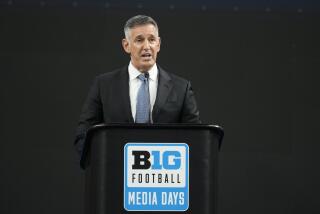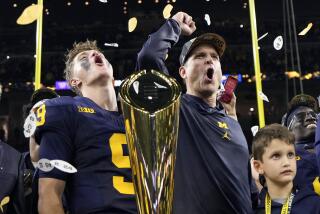Conference chiefs to discuss fixing college football’s BCS — again
“The road ends here” is the definitive catchphrase that NCAA basketball uses to encapsulate a long season culminating at the Final Four.
College football’s postseason bandwagon, meanwhile, continues on rickety wheels over ruts.
Motto: “When will it ever end?”
The answer probably lies somewhere between this week and midsummer.
There can’t be an end of the road to the controversial 14-year-old Bowl Championship Series just yet because two years remain on the existing contract. The Orange Bowl stages next year’s BCS title game followed by the Rose Bowl after the 2013 season.
The heartening news for blood-oath BCS haters, though, is that you can see the end from here.
When college football conference commissioners convene in South Florida starting Wednesday, they will continue to boil down postseason propositions.
They met in New Orleans after January’s BCS title game and reportedly put 50 or 60 ideas on the table.
That number has been narrowed, rather loosely, to four.
However, there are options within those options, which should complicate things enough to extend discussions several more weeks.
College Football’s Final (sort of) Four:
1. Keep the BCS system as it is, with adjustments such as eliminating the “automatic qualifier” status and allowing more than two teams from the same conference to play in major bowls.
Analysis: This won’t satisfy anyone demanding change to and/or threatening lawsuits against a BCS system that many regard as ill-conceived and idiotic and that some argue is illegal.
2. The Original “Plus One”: simply picking No. 1 and No. 2 after the bowl games.
Analysis: The upside is you get another layer of games to let the process play out. It also keeps the existing four BCS bowls as players in the national title race. Detractors would argue this plan doesn’t go far enough toward a playoff.
3. Four-team event.
This has several spinoffs. Seed the top four teams and play three games using the existing BCS bowls: Orange, Sugar, Rose and Fiesta. Or, play the three games at neutral sites selected through a bidding process. Or, play the semifinals in bowls and the title game at a neutral site. Or, play the semifinal games at campus sites, with the title game site selected through a bidding process.
Analysis: This is where it gets sticky. “There are so many details,” BCS Executive Director Bill Hancock said. Games at home sites might benefit teams in cold-weather areas over teams in the South. Using neutral sites, or home campuses, could devalue the major bowls. Imagine the Rose Bowl as just another New Year’s Day game. Travel and logistics are also major concerns.
4. “Four teams plus.”
The four highest-ranked teams meet in two games with this caveat: The Big Ten and Pac-12 champions continue to meet in the Rose Bowl. If either or both champions are ranked in the top four, the other games would be filled by the highest-ranked teams. The top two teams are selected after those three games are played.
Analysis: This plan was obviously pitched to protect the Rose Bowl but has already been knocked down publicly by Southeastern Conference Commissioner Mike Slive, who called it his least favorite option.
No definitive plan is expected to emerge from these meetings, although football’s postseason seems trapped in a vortex between options 2 and 3.
Commissioners may, at best, leave Florida with a working construct to present to their conference presidents. Officials are looking for resolution by midsummer. They want a plan in place for the fall when ESPN, which owns the current four-year package, gets first negotiating rights.
Change from the present BCS format seems inevitable — it just might take another couple of months to make it official.
More to Read
Go beyond the scoreboard
Get the latest on L.A.'s teams in the daily Sports Report newsletter.
You may occasionally receive promotional content from the Los Angeles Times.











